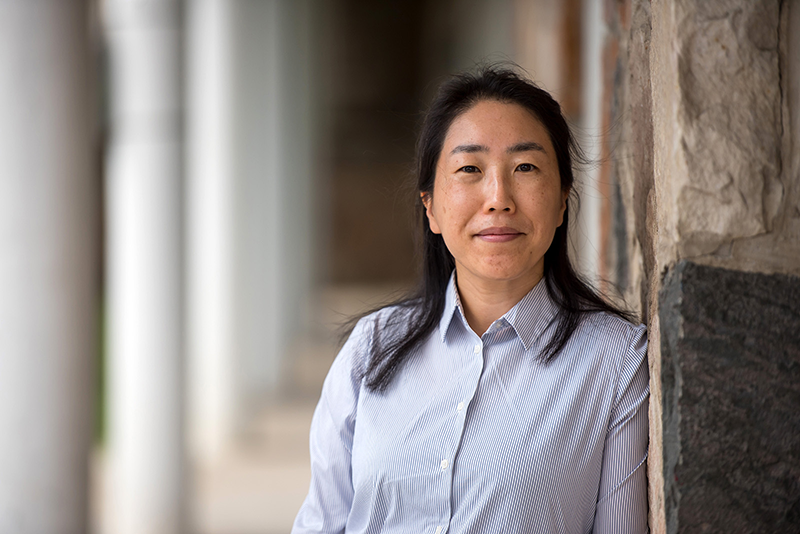The Earth is bombarded with high-energy particles every second, some containing a million times more energy than any produced by the sun. While scientists have been aware of these so-called “cosmic rays” for over a century, their exact origins have remained elusive.
Dr. Nahee Park is working to change that.
Now an Assistant Professor in the department of Physics, Engineering Physics and Astronomy, Dr. Park was first introduced to the study of high energy particles while touring laboratories ahead of her graduate degree in South Korea. “At one of the labs I visited at Ewha Womans University, they were building a detector, and one of the students working on the project said, ‘we’re going to fly this thing into space next year, and then we’ll learn about the explosion of stars by detecting particles’,” she said.
Dr. Park was sold. While obtaining her PhD at Ewha, she twice travelled to the South Pole to take part in the Cosmic Ray Energetics and Mass (CREAM) experiment. The initiative involved flying a balloon rigged with sensors as high as 34 kilometres above the surface of the Earth, in order to measure the intensity and variation in cosmic rays where they would be least impeded by the planet’s atmosphere. As one of just two female scientists on the team of 47 researchers, she was tasked with ensuring that the balloon’s silicon sensors were functioning correctly.
For her efforts with CREAM she received the prestigious young scientist award, and dispensed with some misogynistic tropes about what women could hope to achieve in STEM. “My [high school] math teacher would tell me: ‘you don’t need to know math, you just need to know the right amount of water to use to cook rice,” she said, “it was not encouraged [for women] to be pursuing science.” But with her technical proficiency and strong command of the mathematical concepts, even those that were predisposed to dismiss the work of their female colleagues were forced to recognize the value of Park’s research. “They cannot say anything is wrong with my conclusion if my calculation, estimation, and evaluation is correct,” she said, “I found that very empowering.”

Tracing the origins of cosmic rays is difficult. The particles have been stripped of their electrons by whatever extreme environment created them, leaving only an electrically charged nucleus that is free to interact with any magnetic field in the universe. Each interaction changes the cosmic-ray’s direction of travel, thereby obfuscating its exact place of origin. “We can’t really pinpoint and say, ‘because I got my particle from that direction, the source must be that.’ You need to do a little more involved work to understand what may accelerate these particles,” said Park.
That ‘involved work’ includes efforts like the VERITAS (Very Energetic Radiation Imaging Telescope Array System) gamma-ray observatories and the IceCube Antarctic neutrino observatory, scientific collaborations on which Dr. Park is an active member. High-energy gamma rays and neutrinos are created by the various interactions of the cosmic rays in the Universe. Gamma rays carry no electrical charge, which makes them able to travel pretty much in a straight line from the extreme event that created them, to the Earth’s atmosphere. Once they arrive in our atmosphere, they can be detected by initiatives like VERITAS with which Dr. Park is closely affiliated.
“I was really fascinated with the VERITAS experiment,” she said. “I was looking at particles trying to figure out, ‘where are these from?’, and this is an experiment claiming, ‘oh, we can tell you’.” Gamma ray observations come with limitation as very-high-energy gamma rays cannot travel very far in the Universe. Also, it is not always clear whether the gamma rays are created by the cosmic ray nuclei. Observation of high-energy neutrinos, carried out by IceCube neutrino observatory, can provide the key answer to this problem. IceCube uses an array of 86 sensors buried far below the Antarctic ice, each equipped with several high-sensitivity light detectors, and small computers to relay data back to the surface. The initiative claims to detect an average of 275 neutrinos per day, an impressive number given the fact that nearly 100-million neutrinos pass through our bodies every second, and virtually none of them ever interact with another particle.
“High-energy astrophysics has been evolving really, really quickly,” she said. Dr. Park attributes the advancements in the field to the advent of better particle detection technologies. “Around the time when I was earning my PhD, there was a general idea of what we expected to see, but we couldn’t detect high energy neutrino sources, or diffuse neutrino flux, or anything like that,” she said.
Now at Queen’s, Dr. Park is continuing her search for the origins of high energy particles by capitalizing on the reams of data generated by technological feats like VERITAS and IceCube.
"We are very excited to have Dr. Park join our ranks,” says Rob Knobel, Head of the Department of Physics, Engineering Physics, and Astronomy. "Her impressive range in talents include theoretical modelling and detector design and her research interests, which range from astrophysics to particle physics, complement those of other researchers in the Department. In addition, she displays a strong commitment to teaching and mentoring at the undergraduate and graduate levels."
Dr. Park is also working on developing the next generation of detection technology that will improve the sensitivity and specificity of current approaches. She’s hopeful that this next generation of detectors will bring a higher degree of clarity to the study of cosmic rays and the search for their celestial origins.
“I think these new technologies have the potential to really pin down some of these questions that we have been seeking for over a hundred years,” she said.
“It is exciting, in a way, because you know you are making history.”